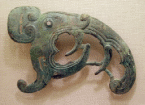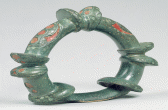Introduction
This paper is aimed at comparing two artifacts that represent different cultures. One of them is a pair of bronze plaques created during the Western Zhou dynasty. The other one is the terret which exemplifies the Celtic culture. It is necessary to show how these objects can throw light on the material culture of these civilizations.
This is one of the methods that are often used by historians or archeologists because such objects are primary sources of information (Adams, Langer, Hwa, & Stearns, 2000). Certainly, one cannot make generalizations only on the basis of such examples; yet, some of the details can be very informative.
The comparison of these exhibits shows how various craftsmen attempted to combine functionality and aesthetic elements. Moreover, it should be mentioned these civilizations achieved a high level of technological development, especially by the standards of the historical periods which these artifacts represent. This is one of the main aspects that should be singled out.
The Exhibit and Artifacts
Much attention should be paid to the pair of bronze plaques (Picture 1). The primary focus will be on this particular subject. One should mention that this artifact was created in China during the period between 1050-771 before the Common Era.

This artifact is an example of craftsmanship which existed during the Western Zhou dynasty which existed for more than two centuries (Higham, 2009). Secondly, one should speak about the terreе (Picture 2) made from a copper alloy (The Metropolitan Museum of Art, 2013). It should be mentioned that these artifacts are parts of larger exhibitions aimed at showcasing the material culture of various civilizations or societies.

Admittedly, these cultures can hardly be related to one another because they represent different geographic regions or historical periods. Nevertheless, they have some similar traits such as sophisticated craftsmanship. The examination of these exhibits can informative and thought-provoking.
Interpretation and Analysis
At first, it is necessary to examine the pair of bronze plaques that exemplify the Chinese art. They resemble mirror images of an animal which curved fangs and gaping mouths (The Art Institute of Chicago, 2013). It cannot be regarded as a cultural or political symbol. More likely, it can be viewed as a tool that had to perform certain functions.
These greenish plaques resemble mirror images of an animal which curved fangs and gaping mouths (The Art Institute of Chicago, 2013). When speaking about this artifact, one should first point out that it was created in the civilization with a relatively sophisticated material culture because these people were able to process metals.
It should be kept in mind that archeologists discovered various bronze artifacts representing the Western Zhou dynasty. For instance, historians often speak about bronze vessels created during this period (Higham, 2009, p. 375). Moreover, this civilization is credited for the development of hydraulic engineering (Higham, 2009).
One should mention that during this period the ancient China had a distinct class of craftsmen who created the majority of artifacts which help researchers study the legacy of this cultural period (Higham, 2009). This is one of the details that should not be overlooked. It is vital for showing that the Chinese society during the Western Zhou dynasty attained significant results in various areas of production.
At present, one can identify only the approximate period when this object was created. This object could be produced between 1050-771 before the Common Era. Furthermore, researchers cannot tell when these plaques were found and identified. Researchers make several conjectures about the use of this artifact. First of all, they could be a part of a horse bridle (The Art Institute of Chicago, 2013).
However, this object could also be a part of the armor (The Art Institute of Chicago, 2013). So, it is quite probable that these bronze plaques could be used by soldiers. However, this is only a conjecture that should be substantiated. Still, this artifact can be informative because it can indicate at the level of technology during the Western Zhou dynasty.
For instance, one can say that this civilization achieved some successes in such an area as metallurgy. Certainly, this area of manufacturing was only at the rudimentary stage of its development. However, at that time, it could be regarded as a remarkable achievement.
This is one of the points that can be made. Such artifacts are important for understanding the life of ancient China. Thus, the examination of this exhibit can be useful for describing the culture of the Western Zhou dynasty.
One should bear in mind that this material is part of a larger collection which is supposed to showcase the material culture of Asian countries. To a great extent, the exhibited artifacts are supposed to represent the diversity of artworks created in such countries as China or Japan.
The pair of bronze plaques help the viewers to gain a better idea about the Asian art which is diverse in terms of styles, the use of materials, and techniques. This is one of the issues that can be singled out.
This pair of bronze plaques can be compared to the terret which represents the Celtic culture. First of all, the second artifact was created much later. In particular, this object was produced in the first century of the Common Era (The Metropolitan Museum of Art, 2013). One cannot say that this terret is a political or cultural symbol. Most likely, this object was used to manage a double harness.
It is one of the metal rings through which the reins were passed. It is made of a copper alloy which is colored in green and white. This terret could be used by soldiers. In particular, one can speak about the drivers of Celtic chariots (The Metropolitan Museum of Art, 2013). These troops were famous for their ability to defeat even overwhelming forces of an enemy (The Metropolitan Museum of Art, 2013).
To a great extent, this material object is also very informative. It shows that the paper the representatives of this culture were skilled at metallurgy and art. One can argue that the ancient Celtic culture attracts close attention of historians and archeologists. There are numerous artworks made of ornamented metals. The chosen artifact illustrates this peculiarity of the Celtic art.
This object is a part of the exhibition which illustrates the artworks created in the Roman Provinces. This exhibition is mostly aimed at showcasing the craft of metalwork which emerged at the beginning of the first of the century of the Common Era.
Moreover, these objects show that the ancient craftsmen attempted to combine functionality with aestheticism. This terret, which is discussed in this paper, fits this exhibition. It resembles other many other exhibits. This is the main argument that can be put forward.
The main similarity is that these material objects served both practical and aesthetic functions. They contain several decorative elements such as tracery. Nevertheless, they were applied for some specific purposes. They might have been used by the cavalrymen. Moreover, both of them represent civilizations with developed metallurgy. Additionally, one can say that the army played an important role in the life of these societies.
These are the main aspects that can be identified. It should be borne in mind that the assumptions made in this paper are other findings of archeologists. By looking only at two examples, one cannot reach definitive conclusions. This is one of the limitations that should not be disregarded. Still, this analysis can give rise to many interesting conjectures. This is one of the main claims that can be advanced.
Conclusion
To a great extent, these examples indicate that the study of material artifacts can throw light on the culture of a certain period. For instance, these objects can help researchers understand the economic and technological development of a country or region during a particular period.
Much attention should be paid to such issues as sophisticated craftsmanship, processing of metals, and people’s willingness to combine aesthetic elements and functionality.
These are the main similarities that should be distinguished. However, one can reach conclusions only by studying a great number of material artifacts. This is the main argument that can be put forward. Although the Celtic and Chinese cultures are not related in any way, they have some common elements.
Reference List
Adams, P., Langer, E., Hwa, L., & Stearns, P. (2000). Experiencing World History. New York, NY: New York University Press.
Higham, C. (2009). Encyclopedia of Ancient Asian Civilizations, New York, NY: Infobase Publishing.
The Art Institute of Chicago. (2013). Asian Art. Web.
The Metropolitan Museum of Art. (2013). Terret (Rein Guide). Web.